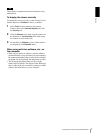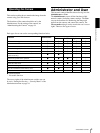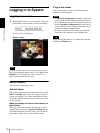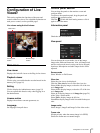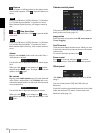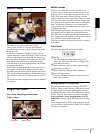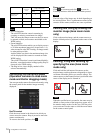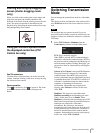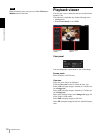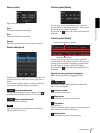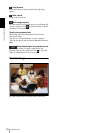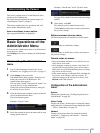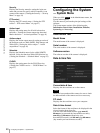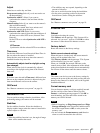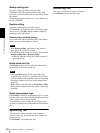
Operating the Camera
Switching Transmission Mode
15
Panning and tilting by dragging the
screen (Vector dragging mode
only)
When you click on the starting point on the image and
drag to the end point, the camera pans/tilts in the
direction of the arrow from the starting point to the end
point. The speed of operation is determined by the
length of arrow. Releasing the button on the mouse stops
the panning/tilting of the camera.
Using pan/tilt/zoom operations with
the displayed control bar (PTZ
Control bar only)
Pan/Tilt operations
Click the arrow of the direction you wish to move the
camera. Continue clicking on the arrow to keep moving
the direction of the camera.
Zoom operation
Click to zoom out, click to zoom in. The zoom
operation continues while you are clicking on the
button.
Switching Transmission
Mode
You can change the transmission mode for video/audio
data.
This function can be used when the video codec mode is
set to H.264 and the ActiveX viewer in the live viewer is
used.
Note
The function may not operate correctly if you use
personal firewall software or antivirus software on your
computer. In that case, disable the software or select the
TCP mode.
1
Select TCP, Unicast or Multicast from the
Connection drop-down list in the Other panel.
TCP: This is normally selected.
When TCP is selected, HTTP communication is
adopted for video/audio communications. HTTP is
the protocol used for reading the usual Web page. In
an environment capable of reading Web pages, you
can watch or listen to video/audio by selecting the
TCP port.
Unicast: When Unicast is selected, RTP (Realtime
Transport Protocol) is adopted for video/audio
communications. Since RTP is the protocol for
running video/audio data, the video/audio playback
is smoother than when TCP (HTTP) is selected. If
a firewall is installed between the camera and the
computer, or depending on the network
environment, video/audio may not play back
properly when Unicast is selected. In this case,
select TCP.
Multicast: This protocol is selectable when
Multicast streaming in the Streaming tab of the
Video / Audio menu is set to Enable. When
Multicast is selected as the transmission port, RTP
(Real-time Transport Protocol) and UDP multicast
techniques are adopted for video/audio
transmission. By selecting it, the network
transmission load of the camera can be reduced. If
a router that does not correspond to a multicast or
firewall is installed between the camera and the
computer, video/audio may not play back properly.
In this case, select TCP or Unicast.



